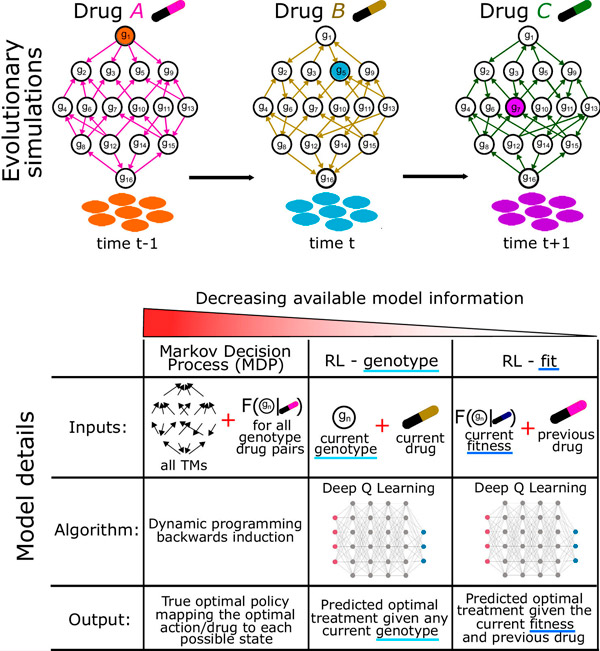Nye publikasjoner
Kunstig intelligens kan utvikle behandlinger for å forebygge "superbakterier
Sist anmeldt: 02.07.2025

Alt iLive-innhold blir gjennomgått med medisin eller faktisk kontrollert for å sikre så mye faktuell nøyaktighet som mulig.
Vi har strenge retningslinjer for innkjøp og kun kobling til anerkjente medieområder, akademiske forskningsinstitusjoner og, når det er mulig, medisinsk peer-evaluerte studier. Merk at tallene i parenteser ([1], [2], etc.) er klikkbare koblinger til disse studiene.
Hvis du føler at noe av innholdet vårt er unøyaktig, utdatert eller ellers tvilsomt, velg det og trykk Ctrl + Enter.

Forskere ved Cleveland Clinic har utviklet en kunstig intelligens-modell (KI) som kan bestemme den beste kombinasjonen og tidspunktet for bruk av legemidler for å behandle en bakteriell infeksjon, utelukkende basert på bakteriens vekstrate under visse forhold. Teamet, ledet av Dr. Jacob Scott og hans laboratorium i den teoretiske avdelingen for translasjonell hematologi og onkologi, publiserte nylig funnene sine i tidsskriftet Proceedings of the National Academy of Sciences.
Antibiotika har fått æren for å ha økt gjennomsnittlig levealder i USA med nesten et tiår. Behandlingene reduserte dødsratene fra helseproblemer vi nå anser som mindre, som noen kutt og skader. Men antibiotika fungerer ikke lenger så bra som de en gang gjorde, delvis fordi de er så mye brukt.
«Globale helseorganisasjoner er enige om at vi går inn i en post-antibiotisk æra», forklarer dr. Scott. «Hvis vi ikke endrer måten vi bekjemper bakterier på, vil flere mennesker dø av antibiotikaresistente infeksjoner enn av kreft innen 2050.»
Bakterier formerer seg raskt og produserer mutante avkom. Overdreven bruk av antibiotika gir bakterier muligheten til å utvikle mutasjoner som er resistente mot behandling. Over tid dreper antibiotika alle mottakelige bakterier, og bare de sterkere mutantene som antibiotika ikke kan drepe, blir igjen.
En strategi leger bruker for å effektivisere behandlinger for bakterielle infeksjoner kalles antibiotikarotasjon. Helsearbeidere veksler mellom forskjellige antibiotika over tid. Å bytte mellom forskjellige legemidler gir bakterier mindre tid til å utvikle resistens mot en bestemt antibiotikaklasse. Rotasjon kan til og med gjøre bakterier mer mottakelige for andre antibiotika.
«Legemiddelrotasjon viser lovende resultater når det gjelder effektiv behandling av sykdommer», sier studiens førsteforfatter og medisinstudent Davis Weaver, PhD. «Problemet er at vi ikke vet den beste måten å gjøre det på. Det finnes ingen standarder for hvilket antibiotikum som skal gis, hvor lenge eller i hvilken rekkefølge.»
Medforfatter av studien, Dr. Jeff Maltas, en postdoktor ved Cleveland Clinic, bruker datamodeller for å forutsi hvordan bakteriers resistens mot ett antibiotikum gjør dem svakere mot et annet. Han slo seg sammen med Dr. Weaver for å se om datadrevne modeller kunne forutsi rotasjonsmønstre for legemidler som minimerer antibiotikaresistens og maksimerer mottakelighet, til tross for den tilfeldige naturen til bakteriell evolusjon.
Dr. Weaver ledet anvendelsen av forsterkningslæring på medikamentrotasjonsmodellen, som lærer en datamaskin å lære av sine feil og suksesser for å bestemme den beste strategien for å fullføre en oppgave. Studien er en av de første som anvender forsterkningslæring på antibiotikarotasjonsordninger, ifølge Dr. Weaver og Dr. Maltas.

Skjematisk evolusjonær simulering og testede optimaliseringsmetoder. Kilde: Proceedings of the National Academy of Sciences (2024). DOI: 10.1073/pnas.2303165121
«Forsterkende læring er en ideell tilnærming fordi du bare trenger å vite hvor raskt bakteriene vokser, noe som er relativt enkelt å bestemme», forklarer Dr. Weaver. «Det er også rom for menneskelig variasjon og feil. Du trenger ikke å måle vekstraten ned til millisekundet hver gang.»
Forskningsteamets kunstige intelligens var i stand til å finne ut de mest effektive antibiotikarotasjonsplanene for å behandle flere stammer av E. coli og forhindre medikamentresistens. Studien viser at kunstig intelligens kan støtte kompleks beslutningstaking, som å beregne antibiotikabehandlingsplaner, sier dr. Maltas.
Dr. Weaver forklarer at teamets AI-modell, utover å håndtere infeksjoner hos én enkelt pasient, kan informere hvordan sykehus behandler infeksjoner generelt. Han og forskerteamet hans jobber også med å utvide arbeidet sitt utover bakterieinfeksjoner til andre dødelige sykdommer.
«Denne ideen er ikke begrenset til bakterier, den kan brukes på ethvert objekt som kan utvikle resistens mot behandling», sier han. «I fremtiden tror vi at denne typen kunstig intelligens kan brukes til å håndtere behandlingsresistente kreftformer.»
